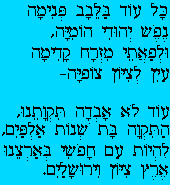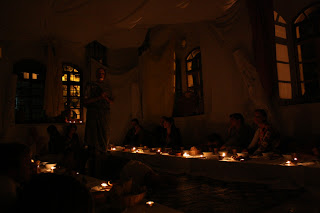...and actually, I'm not just being irreverant. If such a thing as holy smoke exists, then that's what I expericenced today. I suppose that technically it's the fire that is considered holy, but I figure the smoke is connected closely enough to consider it holy too. :)
I probably should start at the beginning. If I can determine where that is. Beginnings can be rather hard to determine and rather hotly debated in this country, believe it or not.
Perhaps I should start with an explanation as to why Easter is celebrated on two different days here in Jerusalem. From what I understand (which may not be entirely correct), part of the Council of Nicea (325AD) was to decide which date to celebrate Easter. The majority of the council agreed to break away from the Jewish system of dating (thus also making a final break with the Jewish community). However, some parties disagreed with this decision (and perhaps others too) and split from the main church. Thus, the Eastern Orthodox and Armenian Churches celebrate Easter on a different day. This year, that happened to be exactly one week after the Protestant and Catholic Easter.
Perhaps next I should explain something that happens on the Saturday of Orthodox Easter weekend. I quote from our Friday AM (school news) publication:
"'The Miracle of the Holy Fire' by Christians from the Orthodox Churches is known as 'The greatest of all Christian miracles'. It takes place every single year, on the same time, in the same manner, and on the same spot. No other miracle is known to occur so regularly and for such an extensive period of time; one can read about it in sources as old as from the eighth Century AD. The miracle happens in the Church of the Holy Sepulchre in Jerusalem, to millions of believers the holiest place on earth."
Still confused? Just wait.
This morning I got up and was reading my Bible and eating breakfast when Cameron came by and asked if I wanted to go with them to see the Holy Fire. He and Matt had been planning to go and had connections with people in the Amenian Church who gave them passes. It ended up that they had an extra pass, so I decided to go with them and Terry, a worker at Jerusalem School in Beit Jala.
We went into the old city through Zion gate and arrived at the Armenian Convent. Eventually, some people they knew came by and invited us inside. It's not really a convent. It's more of a compound where quite a few Armenians live. All their "scouts" were inside with their uniforms, drums, and trumpets, getting reading to march in the parade.
.JPG)
Eventually the procession started, the band leading the way and the rest of us following on foot. It was crowded, but not too terrible.
.JPG)
As we got close to Jaffa Gate, Cameron decided that we should be closer to the band, so we snuck up and managed to start down the road towards the church, just as the police closed the barrier behind us. I think they must have let in more people later, but we felt priviledged. We made it past the next barrier before it was closed, passed the band, and paused before the next barrier as it was opened. There was a bit of a crush there, and some people near me fell down, but we got through that and made it into the chruch. Once inside we weren't quite sure where to go. We had a couple people checking our passes and trying to tell us where to go. Eventually we got to a place, pretty much right next to the tomb, on the south side (to the left as you enter).
It was probably between 11 and 12 when we got into the church...so we had a long wait. We stood for a while, and watched the people around us,
.JPG)
watched people come it, etc. It was pretty crowed, but we were able to sit down on the floor where we were, so we sat for a while and read.
.JPG)
Apparently it is traditional at this time for fights to break out and for some of the Armenians (that our connections were through) to get arrested. Apparently the police really prepared this year because there really was no fighting, at least that I saw.
Eventually the Greek Orthodox, Coptic, and Amenian Churches began their procession around the tomb. They walked around it 3 times. I couldn't really see much of what happened after this, but supposedly the Israeli soldiers (which were out in great number throughout the city and the church today) 'push' their way to the tomb and 'seal' it - enacting what Matthew says the Roman soldiers did to Jesus' tomb on Saturday. Then I think the Greek Orthodox Patriarch enters the tomb and prays. After the prayer, supposedly God sends fire.
I quote again from Friday AM (supposedly this is what the Patriarch sees):
"From the core of the very stone on which Jesus lay an indefinable light pours forth. It usually has a blue tint, but the colour may change and take many different hues. It cannot be described in human terms. The light rises out of the stone as mist may rise out of a lake — it almost looks as if the stone is covered by a moist cloud, but it is light. This light each year behaves differently. Sometimes it covers just the stone, while other times it gives light to the whole sepulchre, so that people who stand outside the tomb and look into it will see it filled with light. The light does not burn — I have never had my beard burnt in all the sixteen years I have been Patriarch in Jerusalem and have received the Holy Fire. The light is of a different consistency than normal fire that burns in an oil lamp... At a certain point the light rises and forms a column in which the fire is of a different nature, so that I am able to light my candles from it. When I thus have received the flame on my candles, I go out and give the fire first to the Armenian Patriarch and then to the Coptic. Hereafter I give the flame to all people present in the Church."
At this point I can again pick up my narrative. People all around were holding groups of candles (33 candles in a bunch, I think, for the years of Jesus' life). As the lighted candle emerged from the tomb, the fire was passed from candle to candle.
.JPG)
Soon there were small blazing fires all around us. The heat, light, and smoke were incredible. It was actually a little scary.
.JPG)
However, it didn't last for long. Most people blew out their candles within about a minute. I even got to help one lady blow hers out. Supposedly, though, the fire from here goes out to churches across the globe and is used to re-light candles (or something like that).
At any rate, fairly soon most of the candles had been extinguished.
.JPG)
The churches began processions around the tomb again, people left, and police barriers inside the church started to come down. We stayed and watched for a while and then made our (crowded) way out of the church, past the rows of police and IDF, and eventually out of the Old City. By this time it was probably about 3:00 and we were hungry. Terry gave us a ride to 24 (the open all-day every-day mini-mart type store) where we got pita and hummas. Yay, food!
Anyway, I have to say it was an interesting experience, and I daresay my description hasn't done it justice, just giving the bare facts as it were. So let me try to give some thoughts and impressions.
First of all, let me emphasize that this is a really big deal. I heard that there were something like 10,000 people in and near the church. The people we stood next to were Armenians from Turkey. Basically, people come from all over, sleep in the church over night, and expend all sorts of effort to be in the church to witness this miracle. To us in the west this behavior seems bizarre. But it's part of their tradition.
.JPG)
Then there's the "miracle." Of course, our first thought is to discount it: the Patriarch takes a lighter in with him and that's where the holy fire comes from. Of course, they have evidence of candles outside the tomb being spontaneously lit, but I'm sure we could come up with some explanation for that too. Probably some joker (like one of the guys I was with) snuck up behind someone and just lit their candles when they weren't looking. Likely enough, that's what happens and there is no real miracle. But could there be a miracle? I don't want to put God in a box: "No, God, you can't do this. It's too weird and unreasonable." Certainly God is powerful enough. And our lack of understanding is hardly a good argument. There are a lot of things about the orthodox church that I don't understand, but I want to learn more. After all, they do claim to be our brothers and sisters in Christ, in spite of obvious differences. Perhaps we could learn some things from them.
It was interesting to see the excitement and passion in all the people around me when the fire emerged from the tomb. It was an interesting experience, just in general. Kind of hard to describe. I don't think I'll plan to go next year, though.










.JPG)











.jpg)
.JPG)
.JPG)
.JPG)
.JPG)
.JPG)
.JPG)
.JPG)
.JPG)






.jpg)








.JPG) Today I went hiking in the Upper Galilee. It was amazing. It's a place with very little Biblical significance, so I hadn't been there. It does have significance to Jewish mysticism, but our reason for going there was simply for pleasure. We started up near the top of Nahal Ammud and hiked some distance down it. There was some scrambling in a couple areas, but in general it was pretty easy, as far as hiking goes. It was beautiful, though, and also mostly deserted except for us, which was nice. I don't think I've ever seen that many wildflowers in my life - they carpeted the hill sides: lovely sights for the eyes and sweet smells for the nose. :)
Today I went hiking in the Upper Galilee. It was amazing. It's a place with very little Biblical significance, so I hadn't been there. It does have significance to Jewish mysticism, but our reason for going there was simply for pleasure. We started up near the top of Nahal Ammud and hiked some distance down it. There was some scrambling in a couple areas, but in general it was pretty easy, as far as hiking goes. It was beautiful, though, and also mostly deserted except for us, which was nice. I don't think I've ever seen that many wildflowers in my life - they carpeted the hill sides: lovely sights for the eyes and sweet smells for the nose. :).JPG)
.JPG)
.JPG)
.JPG)
.JPG)
.JPG)
.JPG)
.JPG)
.JPG)
.JPG)